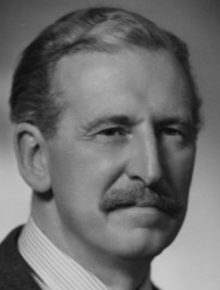
Frederick Gibberd was born in Kenilworth, Coventry, England, on 7 January 1908. He was articled to the firm of Crouch Butter & Savage in Birmingham during which time he studied part-time at Birmingham School of Architecture from 1925 to 1929.
In 1930 he moved to London and from 1930 to 1932 worked as an assistant to the architect Ernest Berry Webber (1896-1963) and in 1932 set up his own practice in London [subsequently known as Frederick Gibberd Partnership and now Gibberd]. In the early days of the practice he shared an office with fellow architect Francis Reginald Stevens Yorke (1906-1962), an avowed Modernist and founder member in 1933 of the Modern Architectural Research (MARS) Group. They collaborated on a number of projects and were joint authors of influential book The Modern Flat (London: The Architectural Press, 1937).
Gibberd was declared unfit for military service during World War Two and was initially engaged in the design of air raid shelters. In 1942 he was appointed Principal of the Architectural Association School of Architecture in London a post he held until 1944.
Gibberd was elected a Licentiate of the Royal Institute of British Architects (LRIBA) in 1938; a Fellow of the Royal Society of British Architects (FRIBA) in 1939; an Associate of the Royal Academy (ARA) in 1961; and a Royal Academician (RA) in 1969. He was also a Fellow of the Society of Industrial Artists (FSIA), and in the 1930s was a member of the MARS Group. In 1967 he was knighted for services to architecture. He received the European Architectural Heritage Award in 1975 and the Royal Town Planning Association’s gold medal.
Gibberd was the author of several books of books on architecture planning and design. He died in Harlow, Essex, on 9 January 1984.
Gibberd designed his first significant building, Pullman Court, a block of modern-style flats in Streatham Surrey [now London] in 1934-36 which was well received in the architectural press, however it was not until after the war that he began to make his presence known as an architect with a number of high-profile commissions including London Airport, Heathrow (1950-1969), the Roman Catholic Metropolitan Cathedral of Christ the King in Liverpool (1960-67), the Inter-Continental Hotel in London (1968), London Central Mosque (1969), Coutts Bank in the Strand, London (1969), Kielder Reservoir (1969) and the Harpur Centre Shopping Centre in Bedford (1969). He was also Architect-Planner for Harlow New Town in Essex (1946-72), and was planning consultant for a number of other authorities.
See also:
Historic England - 73 architectural projects by Frederick Gibberd
British Listed Buildings - 21 listed buildings by Frederick Gibberd
Contemporary Architects. Edited by Ann Lee Morgan and Collin Naylor. Chicago and London: St. James Press, 2nd edition, 1987 [Contains a comprehensive list of Gibberd's work 1933-1973 p. 315. Bibliography below]
Contemporary Architects. Edited by Ann Lee Morgan and Collin Naylor. Chicago and London: St. James Press, 2nd edition, 1987 [Contains a comprehensive list of architectural projects by Gibberd and details of writings by and about him]
Gibberd, Frederick. ‘Mass produced house design’ in The Practice of Design, edited by Herbert Read. London: Lund Humphries, 1946 pp. 86-108
Harwood, Elain. Mid-Century Britain: Modern Architecture 1938-1963. London: Batsford, 2021
Manley, Christine Hui Lan. Frederick Gibberd. London: Historic England, 2017
Mills, Edward David. The New Architecture in Britain 1946-1953. London: The Standard Catalogue Co., 1953 [Discusses "The Lawn" flats in Harlow, Essex designed by Frederick Gibberd pp. 129-140]
Mills, John Fitzmaurice. 'The new Liverpool Metropolitan Cathedral' Connoisseur vol. 166, December 1967 pp. 225-231 {A description of Liverpool Metropolitan Cathedral designed by Frederick Gibberd and built 1962-67]
Moon, R. C. 'Nuneaton: a plan for the town centre'. Architects' Journal vol. 108, 2 September 1948 pp. 221-224 [Discusses Gibberd's role as consultant in planning the redevelopment of the town of Nuneaton, badley damaged during World War Two]
Powers, Alan. Modern. The Modern Movement in Britain. London: Merrell, 2005
Robson-Smith, N. and Tomlinson, A. H. 'Environmental qualities of urban open space challenged: an appraisal of Queen's Gardens, Kingston upon Hull'. The Builder vol. 219, 2 October 1970 pp. 65-74 [An assessment of the design and layout of Queen's Gardens, Kingston upon Hull by Frederick Gibberd]
Taylor, Nicholas. 'Harlow Town Centre. Architectural Review vol. 136, September 1964 pp. 220-222 [Discusses the first phase of Frederick Gibberd's plan for Harlow New Town in Essex completed in 1964]
Taylor, Nicholas. 'Metropolitan Cathedral, Liverpool'. Architectural Review vol. 141, June 1967 pp. 436-448 [The Metropolitan Cathedral of Christ the King, Liverpool, designed by Frederick Gibberd and completed in 1967]
Thirties: British Art and Design before the War. London: Arts Council of Great Britain, 1979 [Catalogue of an exhibition at the Hayward Gallery, London, 25 October-13 January 1979]
White, William. 'the altar and the liturgy'. RIBA Journal vol. 74, July 1967 pp. 281-285 [the planning and internal arrangement of the Metropolitan Cathedral of Christ the King, Liverpool, designed by Frederick Gibberd and completed in 1967]